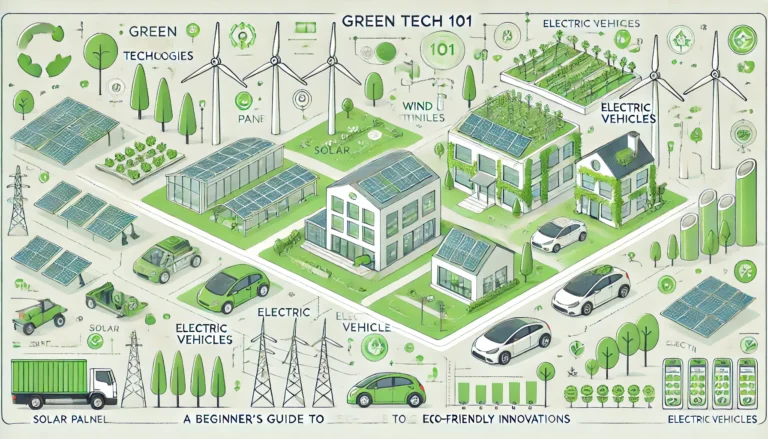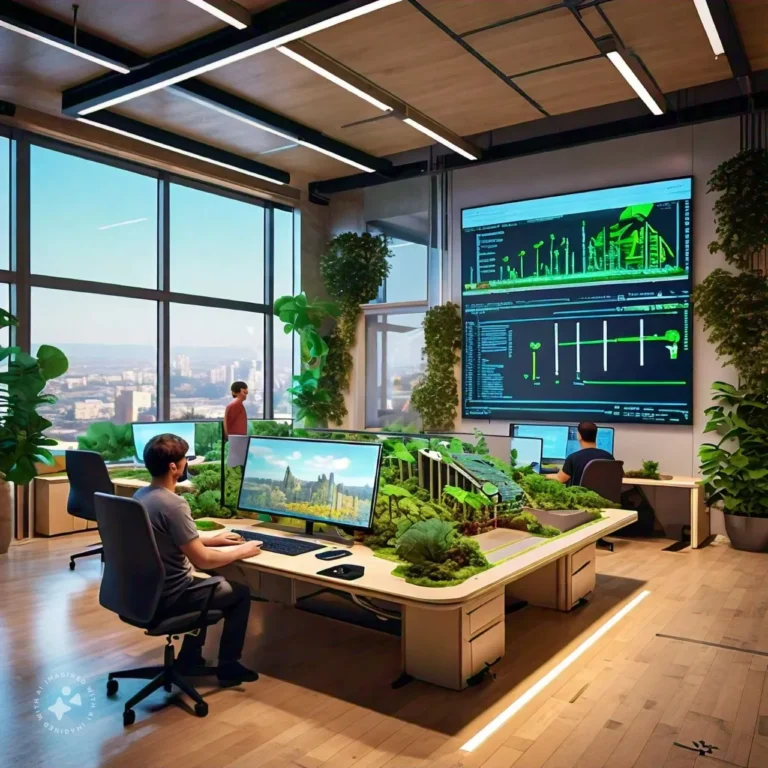Why Green Tech Software is Crucial for Future Growth in the Tech Industry
Introduction
As we progress through the 21st century, this compound of technology and sustainability has emerged as a key domain touched by innovation. Software designed to improve environmental sustainability, which can range from simple process optimization solutions and supply chain tracking systems through software for curing cancer or dealing with other world problems via computer calculations, is growing in importance both as a potential disruptive figure and greater agility. In this in-depth analysis, we explain why green tech software is crucial for the technology sector of tomorrow by looking at what it means for businesses and society as a whole.
Importance of Sustainability on the Rise
The Environmental Imperative
We are in a world where sustainable solutions have never been needed more. Climate change, resource shortages, and environmental devastation are challenges requiring urgent global action. Tech, a sector often associated with speed of development and impact, is well-suited to be on the frontlines for such dramatic transformation. Green tech software is a key element in this change by allowing for the creation and use of a series of tools intended to lessen our carbon footprints, make better use of resources, and overall follow-through on sustainable behavior.
Consumer and Corporate Demand
There is a growing trend where modern, environment-savvy consumers look for brands that share the same values with them. This change in consumer behavior has pushed companies to pursue sustainable practices. In addition, investors have turned their focus to Environmental, Social, and Governance (ESG) factors in order for businesses to incorporate green technologies into their practices. Green tech software achieves this by providing solutions that improve the environmental performance and transparency of companies.

The Future of Green Tech Software in Industries
Enhancing Energy Efficiency
The largest impact of green tech software is in energy efficiency. One great example is the data centers that are at the heart of how most digital businesses operate, which suck up ginormous amounts of resources. Software solutions can be much more efficient with server workloads and reduce energy consumption through controlling the cooling system better. For example, machine learning algorithms can forecast server loads and change power usage on the fly, saving a great deal of energy.
Reducing E-Waste
The term e-waste (electronic waste) refers to the equipment for which reasonable measures are taken at disposal that may be employed in aggregative. One of the ways that green tech software can help solve this is to make these electronic devices last longer so as not to become obsolete and go right back into recycling. Preventive maintenance software will likely know that a piece of hardware is about to fail ahead before it happens, saving time on repairs and at least avoiding replacements. Moreover, software-based recycling efforts could make it easier to collect and process e-waste consistently so that the valuable materials are reclaimed and hazardous components properly disposed of.
Smart Grid and Renewable Integration
Renewable energy integration with the grid: The renewable generation integrated into the electric power system provides opportunities and challenges. Some of the hottest green tech software is designed to help utilities manage smart grids that balance supply and demand in real-time. These software solutions make it possible to distribute electricity more effectively through renewable generation, such as solar and wind power; they increase grid stability, and reduce dependence on fossil fuels. In addition to this, green tech software can also propel the evolution of energy storage systems, which are crucial as they help in solving one of the most challenging aspects associated with renewable power, that is, its intermittent nature.
Sustainable Supply Chain Development
The tech industry’s supply chains are integral, and sustainability is key. Through green tech software, we provide solutions to track and manage supply chain environmental footprints. Transparency and traceability are provided by blockchain technology, meaning that materials will be accountable for the way consumers use them. Meanwhile, software platforms streamline logistics to lower transportation emissions (as well as waste). These advancements will assist companies in creating a stronger and more eco-friendly supply chain.
Green Tech Software Case Studies
Google’s Data Centers
Since Google has been at the forefront of leveraging green tech software for sustainability in its operations, the bunch of services are powered through AI algorithms to minimize energy consumption within the data centers, used by Microsoft. These AIOPs use the methods of machine learning algorithms designed to analyze historical data and predict future workloads, adjusting systems as per requirement for cooling & server operations. Subsequent across the industry has allowed Google to cut their own use from potential and CO2 footprints by a lot, really veterans in this respect.
Tesla’s Energy Solutions
Tesla is not just a company that manufactures cars, but the head of its own green technology. For example, the firm’s energy solutions — like Powerwall and Powerpack — are based on advanced software for controlling energy storage and distribution. By allowing the home or business to get and store solar energy, then use it during peak demand periods, these products help take stress off the conventional grid. Tesla’s software also works with renewable energy sources, delivering a continuous and efficient way of managing power.
Environmental Intelligence from IBM
IBM Environmental Intelligence Suite, a holistic software solution that provides companies with better management of their environmental footprint. It comprises tools for monitoring weather conditions, forecasting environmental threats, and optimizing resource utilization. IBM uses AI and data analytics to produce insights that focus on sustainable action for businesses. Best suited for agriculture, manufacturing, and logistics sectors due to high environmental dependency on these industries.
Advantages of Green Tech Software on Economy
Cost Savings
This is a significant financial cost saving for businesses when investing in green tech software. More energy-efficient solutions can lower utility bills, and more reliable predictive maintenance controls unplanned downtime while reducing repair costs. Furthermore, by streamlining supply chains and logistics, the cost of transportation can be reduced. These savings can contribute to both the bottom line and help free up resources for further innovation, thus growth.
Competitive Advantage
Your competitors are not using software that runs on green tech. Management Approach: Companies with sustainable business practices have better ecosystems; they are more consumer-friendly, investment-worthy, and talent magnets. Positioning the green alternative can increase a brand’s reputation with customers and word-of-mouth, improving sales performance and increasing market share. In addition, companies that excel in sustainability are more likely to meet regulations and avoid fines, lessening operational risks.
Features Innovation & Growth Opportunities
Green tech software is developed and new green growth markets open. Both startups, as well as traditional tech companies, are at work exploring solutions for environmental problems. This way of thinking creates an environment that empowers innovation and problem-solving, supporting advancements in areas like AI, IoT, big data, or blockchain. If it can, the tech industry will continue to prosper while serving a nearly carbon-free future.
Challenges in the Adoption of Green Tech Software
Barriers of Technology and Money
However, along with many of its advantages comes one challenge stationary in the gas station[…] Implementation may be hindered by technical barriers throughout the process, for example, due to the complexity of integrating new solutions with existing systems. Furthermore, the high initial costs of green technology may present a very real barrier to some businesses – SMEs for example. The partnership approach, government incentives, and phased implementation strategies are ways to address these challenges.
Security and Privacy of the Data
Application of green tech software usually needs a lot of data to be prepared and analyzed. As we know, any data breach, either happening in local or cloud storage, can have grave consequences. And of course, companies must develop cybersecurity and data protection capabilities in line with strict regulation. This would be able to create trust by using transparent data practices and getting informed consent from users, while still addressing the issues of privacy.
Measure and Report on Success
The last cornerstone is how well green tech software can be measured to evaluate its impact, effectiveness, and areas for improvement. Standardized metrics and reporting frameworks can be difficult to develop. Companies should work together with industry organizations, NGOs, and regulators to establish good practices around measurement and reporting on sustainability. Using sophisticated analytics and reporting tools can also improve reliability and transparency.
Where Green Tech Software is Heading
Emerging Technologies Integrations
The future of green tech software is in its integration with emerging technologies. For instance, the Internet of Things (IoT) can allow all machines and systems to be connected so that energy consumption rate monitoring occurs in real-time. Blockchain technology can improve transparency and traceability in supply chains to ensure that sourcing and production are both sustainable. On the other hand, AI technology and machine learning must develop as such innovations will lead to more sophisticated green tech solutions for a longer period.
Application and Industry Expansions
Despite the fact that green tech software is already having major effects in certain areas such as energy, manufacturing, and logistics, we are seeing new growth of applications within further industries. Green tech software could enable significant environmental and economic benefits when applied to agriculture, and healthcare, and finance. A good example of this is that precision agriculture technologies are able to make more efficient use of resources, which helps reduce the human impact on the environment, or platforms like green finance can help recycling practices in sustainable investments.
International Collaboration and Standardization
Realizing the potential of green tech software necessitates collaboration and standardization globally. To achieve this, governments should cooperate with industry leaders and international organizations to foster regulation, and spread best practice ideas on how new technologies could be implemented safely and productively. With consistent foundational metrics and the possibility for global reporting, we would create transparency across the sector that builds trust in green innovation to drive acceleration on a worldwide scale.
Conclusion
Green tech software is not a fad but rather the future of which the tech industry overall functions. It is especially important in agitating some of the titanic environmental problems that we face and to better attend economic growth. Green tech software offers an array of tangible benefits for businesses and the environment, promoting sustainability while reducing e-waste, advancing smart grid infrastructure, and supporting sustainable supply chains by saving energy. In an evolving tech industry, green will be a competitive advantage in the future and driving innovation that helps to build the mantra of sustainable development for now. The adoption of green tech software today is an investment in our greener and more prosperous tomorrow.







